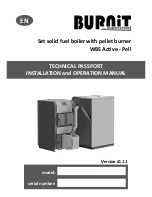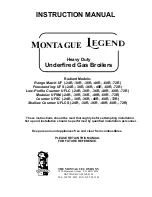
14
TECHNICAL PASSPORT. INSTALLATION and OPERATION MANUAL
TECHNICAL PASSPORT. INSTALLATION and OPERATION MANUAL
TECHNICAL PASSPORT. INSTALLATION and OPERATION MANUAL
TECHNICAL PASSPORT. INSTALLATION and OPERATION MANUAL
Table 4.1 TROUBLE-SHOOTING TABLE - when burning solid fuel
Cause
Solution
Installation damage
1.
Due to unsealed connections
1.
Install the connecting piping strain-free to the boiler
connections. Connect the heating installation outlet to
connection B. Connect the heating installation inlet to
connection A. Mount the cock Y included in the set.
2.
Due to accumulation of deposits.
Condensate and tar formation may
reduce the performance and life of
the heating boiler. The temperature
at the boiler inlet must not be
less than 65°C, boiler water
temperature at the outlet must be
between 80°C and 85°C.
2.
It is mandatory to install a three-way thermostatic
valve which will prevent the temperature dropping
under 65°C at the inlet.
-
In order to increase the operational life of the
boiler it is recommended to install a buffer vessel with
capacity of 55 l per 1 kW of installed power.
3. Due to freezing
3.
If the heating installation, including the piping
network, has not been built frost-proof, we recommend
that you fill the heating installation with a liquid which
has low freezing point and corrosion protection and
antifreeze agent.
Output too low
1.
Insufficient draught
1.
Check chimney condition and measure draught.
(must be performed by an authorized service)
2.
Heating value of the fuel is too
low.
2.
Make sure you use sufficiently dry fuel. When using
fuel with high moisture content, after the reloading the
boiler may burn for some time at significantly lower
output level until the fuel in the combustion chamber
has dried.
3.
Presence of soot deposits and/or
tar on the flue damper in the upper
chamber which prevent its tight
closure
.
3.
Clean the flue damper and make sure that when
moving its closing/opening lever it provides adequate
sealing of the flue gas outlet in the upper chamber.
(must be performed by an authorized service)
4.
Presence of soot deposits and/or
tar in the flue pipes in water jacket
in the back of the boiler
4.
Clean the heat exchange surface of the flue pipes
using the brush from the cleaning tools set. After the
cleaning is completed, remove any soot through the
inspection opening in the back of the boiler. Must be
performed by an authorized service.
Boiler water too hot, heating bodies too cold
1. Hydraulic resistance is too high.
2. Air in the system
3. Inoperable circulation pump
Make sure the circulation pump has been properly
selected and the heating installation is of the proper
dimensions. (You must contact your installer.)
Boiler temperature too high. Controller failure
1. Grid power fluctuations
2. Power failure
It is mandatory to assure a backup power generator of
corresponding rated power! (see 14.2)















































